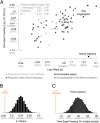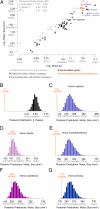Phylogenetic rate shifts in feeding time during the evolution of Homo
- PMID: 21873223
- PMCID: PMC3167533
- DOI: 10.1073/pnas.1107806108
Phylogenetic rate shifts in feeding time during the evolution of Homo
Abstract
Unique among animals, humans eat a diet rich in cooked and nonthermally processed food. The ancestors of modern humans who invented food processing (including cooking) gained critical advantages in survival and fitness through increased caloric intake. However, the time and manner in which food processing became biologically significant are uncertain. Here, we assess the inferred evolutionary consequences of food processing in the human lineage by applying a Bayesian phylogenetic outlier test to a comparative dataset of feeding time in humans and nonhuman primates. We find that modern humans spend an order of magnitude less time feeding than predicted by phylogeny and body mass (4.7% vs. predicted 48% of daily activity). This result suggests that a substantial evolutionary rate change in feeding time occurred along the human branch after the human-chimpanzee split. Along this same branch, Homo erectus shows a marked reduction in molar size that is followed by a gradual, although erratic, decline in H. sapiens. We show that reduction in molar size in early Homo (H. habilis and H. rudolfensis) is explicable by phylogeny and body size alone. By contrast, the change in molar size to H. erectus, H. neanderthalensis, and H. sapiens cannot be explained by the rate of craniodental and body size evolution. Together, our results indicate that the behaviorally driven adaptations of food processing (reduced feeding time and molar size) originated after the evolution of Homo but before or concurrent with the evolution of H. erectus, which was around 1.9 Mya.
Conflict of interest statement
The authors declare no conflict of interest.
Figures



Similar articles
-
The affinities of Homo floresiensis based on phylogenetic analyses of cranial, dental, and postcranial characters.J Hum Evol. 2017 Jun;107:107-133. doi: 10.1016/j.jhevol.2017.02.006. Epub 2017 Apr 21. J Hum Evol. 2017. PMID: 28438318
-
Homo floresiensis: a cladistic analysis.J Hum Evol. 2009 Nov;57(5):623-39. doi: 10.1016/j.jhevol.2009.05.002. Epub 2009 Jul 23. J Hum Evol. 2009. PMID: 19628252
-
Relative tooth size, Bayesian inference, and Homo naledi.Am J Phys Anthropol. 2021 Oct;176(2):262-282. doi: 10.1002/ajpa.24353. Epub 2021 Jun 30. Am J Phys Anthropol. 2021. PMID: 34190335
-
The reversal of human phylogeny: Homo left Africa as erectus, came back as sapiens sapiens.Hereditas. 2020 Dec 19;157(1):51. doi: 10.1186/s41065-020-00163-9. Hereditas. 2020. PMID: 33341120 Free PMC article. Review.
-
The human genus.Science. 1999 Apr 2;284(5411):65-71. doi: 10.1126/science.284.5411.65. Science. 1999. PMID: 10102822 Review.
Cited by
-
First Bites-Why, When, and What Solid Foods to Feed Infants.Front Pediatr. 2021 Mar 26;9:654171. doi: 10.3389/fped.2021.654171. eCollection 2021. Front Pediatr. 2021. PMID: 33842413 Free PMC article. Review.
-
Crocodylian Head Width Allometry and Phylogenetic Prediction of Body Size in Extinct Crocodyliforms.Integr Org Biol. 2019 Mar 23;1(1):obz006. doi: 10.1093/iob/obz006. eCollection 2019. Integr Org Biol. 2019. PMID: 33791523 Free PMC article.
-
Microstratigraphic evidence of in situ fire in the Acheulean strata of Wonderwerk Cave, Northern Cape province, South Africa.Proc Natl Acad Sci U S A. 2012 May 15;109(20):E1215-20. doi: 10.1073/pnas.1117620109. Epub 2012 Apr 2. Proc Natl Acad Sci U S A. 2012. PMID: 22474385 Free PMC article.
-
Dental abrasion as a cutting process.Interface Focus. 2016 Jun 6;6(3):20160008. doi: 10.1098/rsfs.2016.0008. Interface Focus. 2016. PMID: 27274807 Free PMC article.
-
The cost of chewing: The energetics and evolutionary significance of mastication in humans.Sci Adv. 2022 Aug 19;8(33):eabn8351. doi: 10.1126/sciadv.abn8351. Epub 2022 Aug 17. Sci Adv. 2022. PMID: 35977013 Free PMC article.
References
-
- Wrangham R. Catching Fire: How Cooking Made Us Human. New York: Basic Books; 2009.
-
- Boback SM, et al. Cooking and grinding reduces the cost of meat digestion. Comp Biochem Physiol A Mol Integr Physiol. 2007;148:651–656. - PubMed
-
- Carmody RN, Wrangham RW. The energetic significance of cooking. J Hum Evol. 2009;57:379–391. - PubMed
-
- Ellison PT. Energetics and reproductive effort. Am J Hum Biol. 2003;15:342–351. - PubMed
-
- Koebnick C, Strassner C, Hoffmann I, Leitzmann C. Consequences of a long-term raw food diet on body weight and menstruation: Results of a questionnaire survey. Ann Nutr Metab. 1999;43:69–79. - PubMed
Publication types
MeSH terms
LinkOut - more resources
Full Text Sources

